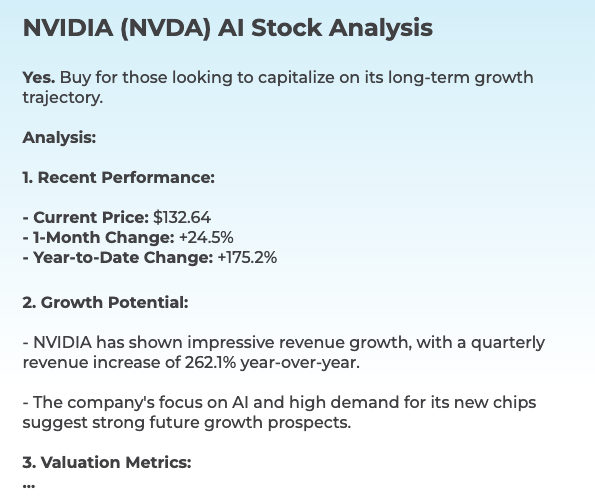20 Top Tips On Deciding On AI Stock Picker Analysis Sites
20 Top Tips On Deciding On AI Stock Picker Analysis Sites
Blog Article
Top 10 Things To Consider When Considering Ai And Machine Learning Models On Ai Trading Platforms
It is essential to examine the AI and Machine Learning (ML) models that are employed by stock and trading prediction platforms. This ensures that they offer accurate, reliable and practical information. Overhyped or poorly designed models could lead to inaccurate predictions and even financial loss. Here are the top ten tips for evaluating the AI/ML models of these platforms:
1. Understanding the model's purpose and method of operation
Clear objective: Determine whether the model was created to be used for trading short-term or long-term investments, or sentiment analysis, or risk management.
Algorithm disclosure: Find out if the platform discloses which algorithms it employs (e.g. neural networks and reinforcement learning).
Customizability - Determine if you can tailor the model to suit your investment strategy and risk tolerance.
2. Evaluation of Performance Metrics for Models
Accuracy - Check the model's prediction accuracy. Don't base your decisions solely on this metric. It can be misleading regarding financial markets.
Precision and recall (or accuracy) Assess how well your model is able to differentiate between genuine positives - e.g., accurately predicted price changes as well as false positives.
Risk-adjusted results: Evaluate the impact of model predictions on profitable trading in the face of accounting risks (e.g. Sharpe, Sortino and others.).
3. Test the model by Backtesting
Historical performance: Use the historical data to backtest the model and determine how it would have performed in the past under market conditions.
Test the model on data that it hasn't been trained on. This will help to prevent overfitting.
Scenario Analysis: Review the model's performance under various market conditions.
4. Check for Overfitting
Overfitting signals: Look out for models performing extraordinarily well with data training but poorly on data that isn't seen.
Regularization techniques: Determine whether the platform is using methods like regularization of L1/L2 or dropout to prevent overfitting.
Cross-validation is essential and the platform must use cross-validation when assessing the generalizability of the model.
5. Assessment Feature Engineering
Look for features that are relevant.
Select features: Ensure you only choose important statistically relevant features and does not include redundant or irrelevant information.
Updates of dynamic features: Make sure your model is updated to reflect new features and market conditions.
6. Evaluate Model Explainability
Interpretability (clarity) Clarity (interpretation): Make sure to verify that the model explains its predictions clearly (e.g. importance of SHAP or the importance of features).
Black-box models: Beware of platforms that use excessively complex models (e.g., deep neural networks) without explanation tools.
User-friendly Insights: Verify that the platform provides actionable insight in a format traders can easily understand and utilize.
7. Test the ability to adapt your model
Changes in the market - Make sure that the model can be adapted to changes in market conditions.
Check for continuous learning. The platform should be updated the model often with new information.
Feedback loops. Make sure that your model is incorporating the feedback from users as well as real-world scenarios to improve.
8. Check for Bias during the election.
Data bias: Ensure the training data is representative of the market and free of biases (e.g. excessive representation of particular sectors or time periods).
Model bias: Determine if you are able to monitor and minimize biases that exist in the forecasts of the model.
Fairness: Ensure the model doesn't unfairly favor or disadvantage certain sectors, stocks or trading strategies.
9. The Computational Efficiency of the Program
Speed: Check whether the model is able to make predictions in real-time, or with minimal latency. This is crucial for traders who trade high-frequency.
Scalability: Find out whether the platform has the capacity to handle large amounts of data with multiple users, and without any performance loss.
Resource usage: Determine whether the model is using computational resources effectively.
Review Transparency and Accountability
Model documentation: Ensure that the model platform has complete documentation about the model's design, the process of training and its limitations.
Third-party audits : Verify if your model was audited and validated independently by third parties.
Check that the platform is fitted with a mechanism to identify model errors or failures.
Bonus Tips:
Reviews of users and Case studies Review feedback from users and case studies to evaluate the actual performance.
Trial period: Try the model for free to see how accurate it is and how simple it is to utilize.
Customer Support: Make sure that the platform provides solid technical or model-related assistance.
The following tips can help you assess the AI models and ML models available on platforms for stock prediction. You will be able determine if they are transparent and trustworthy. They should also align with your trading objectives. Check out the most popular ai investing platform for more examples including ai trading tools, chatgpt copyright, ai stock trading app, ai investing, ai for investment, ai investing, chatgpt copyright, chart ai trading assistant, chatgpt copyright, ai for stock trading and more.
Top 10 Tips For Evaluating The Latency And Speed Of Ai Trading Platforms
For algorithmic, high-frequency and active traders in particular speeds and latencies are key factors when looking at AI platforms to forecast stock prices and analyze. A delay of just milliseconds can impact trade execution and profitability. Here are the 10 best ways to measure the speed of the platform.
1. Examine the Real-Time Data Feeds
Speed of data delivery - Make sure that the platform can provide real-time data with a minimal delay (e.g. the sub-millisecond delay).
Verify the source's proximity to the most important exchanges.
Data compression: Look for effective methods for data compression that can speed up the delivery of data.
2. Time to test trade execution
Order processing time The amount of time that it takes the platform to process and execute trades after you have placed an order.
Direct market access: Ensure that the platform allows direct orders to be made to the exchange.
Execution reports: Check whether the platform has detailed execution reports, including timestamps for the submission of orders, confirmation of orders, and fill.
3. Review the responsiveness of the Platform
User interface speed (UI) Test how quickly the user interface of the platform responds to your inputs.
Chart updates: Check that charts and visuals are updated in real-time, without delay.
Performance of mobile apps. When using an app designed for mobile, you should ensure it's running as fast and smoothly as a desktop application.
4. Find out if the network infrastructure is low-latency.
Server locations: Make sure the platform is using low-latency servers located near major financial hubs or exchanges.
Co-location services: Check whether the platform provides co-location services, allowing you to host your trading algorithm on servers close to the exchange.
High-speed networks: Verify if the platform uses fiber-optic networks that are high-speed or low-latency technologies.
5. Test simulation speed and backtesting
Find out how quickly the platform analyses and processes the historical data.
Simultaneous trade simulation: The platform should be able to simulate live trading with no obvious delay.
Parallel processing: Check that your platform supports parallel processing, also known as distributed computing, to speed complicated computations.
6. Determine API Latency
API response times: Find out how fast APIs respond to requests (e.g. retrieving data from the platform, or placing orders).
Rate limits. Verify whether there are acceptable limits on the API. This can aid in preventing delays during high-frequency transactions.
WebSocket Check if the platform supports WebSocket protocols that allow streaming data in real time with minimal latency.
7. Test Platform Stability using Load
High-volume trading: Play high-volume trading scenarios to assess whether the platform is reliable and stable.
Check your platform out during periods of market volatility.
Test your strategies for stress: See if the platform offers the tools to stress test your strategies under extreme conditions.
8. Assess Connectivity and Network
Internet speed requirements: Ensure your internet connection is running at the recommended speed of your platform.
Redundant connections: Find out if the platform has redundant internet connections to prevent interruptions.
VPN latency. If you are using VPN, VPN be sure to check whether it creates a significant amount of latency.
9. Make sure you are using Speed Optimization features.
Pre-trade Analytics: Be sure the platform has pre-trade analytics to improve order routing, execution speed and other factors.
Smart Order Routing (SOR). Make sure that the platform utilizes SOR to identify the quickest and most cost efficient execution venues.
Monitoring latency Make sure your platform lets you track and analyze your latency live.
Check out the feedback of users and benchmarks
Reviews from users: Search for feedback from users on the site to gauge its speed and latencies.
Third-party benchmarks: Search for independent benchmarks or reviews comparing the speed of the platform to other platforms.
Case studies: Contact the platform to see if it has cases studies or reviews that demonstrate its capabilities with low latency.
Bonus Tips:
Trial period: Try out an unpaid test or demo of the platform to test the performance of the platform in real scenarios.
Customer support: Ensure the platform provides support for latency-related issues or for optimization.
Hardware requirements: Determine whether you require specific equipment to achieve the highest performance (e.g. high-performance PCs).
The following tips can aid in assessing the performance of AI trading platforms that predict/analyze the prices of stocks. You can choose a trading platform which best suits the requirements of your trading and eliminates delay. The ability to reduce latency is crucial for high-frequency or algorithmic traders where even a small delay could affect their performance. Take a look at the recommended best ai trading platform for website info including ai in stock market, free ai stock picker, ai options trading, chart analysis ai, free ai tool for stock market india, ai share trading, best ai for stock trading, ai stock prediction, best ai trading platform, how to use ai for copyright trading and more.